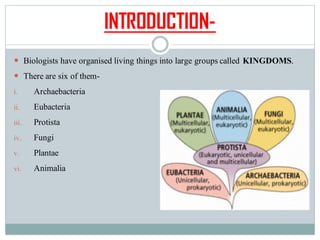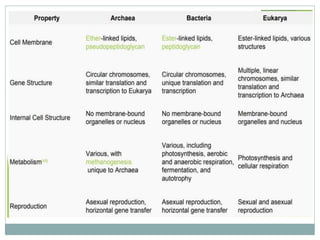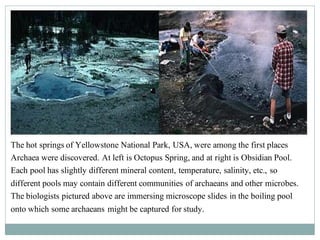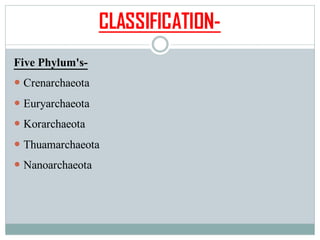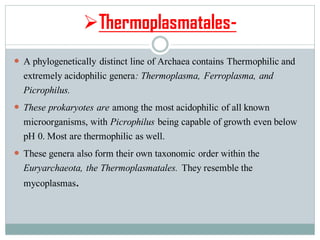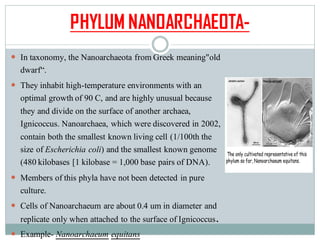Archaebacteria
- 1. SU BMIT T E D T O - SU BMIT T E D BY - MRS.JAY A MAT HU R AD IT I BAGD I ASSIST AN T PRO F E SSO R AT MSBT 1S T SE M. L AC HO O ME MO RIAL C O L L E GE BIO T E C HN O L O GY O F SC IE N C E AN D T E C HN O L O GY . LACHOO MEMORIAL COLLEGE OF SCIENCE AND TECHNOLOGY
- 3. CONTENTS- Introduction The domain archaea Evolutionary relationship between three domains Some basic facts Kingdom archaebacteria Characteristics of archaebacteria Morphological features of Archaebacteria Archaeal Cell wall Archaeal plasma membrane Classification I. Crenarchaeota II. Euryarchaeota III. Korarchaeota IV. Thaumarchaeota Importance of archaebacteria
- 4. INTRODUCTION- Biologists have organised living things into large groups called KINGDOMS. There are six of them- i. Archaebacteria ii. Eubacteria iii. Protista iv. Fungi v. Plantae vi. Animalia
- 5. THE DOMAIN ARCHAEA- In 1996, scientists decided to split Monera into two groups of bacteria: Archaebacteria and Eubacteria. Because these two groups of bacteria were different in many ways scientists created a new level of classification called a DOMAIN. Now we have 3 domains 1. Bacteria 2. Archaea 3. Eukarya
- 7. Evolutionary relationship between three domains- There are many similarities and differences between the three domains. Bacteria and Archaea differ in how they gain energy. Bacteria gain energy either by being phototrophs, lithotrophs or organotrophs. One similarity between domain Archaea and domain Bacteria is that they both contain only prokaryotes while domain Eukarya only contains eukaryotes. Domain Archaea is the only domain that is sensitive to antibiotics. Another similarity between domain Bacteria and domain Eukarya is that Methionine is the first amino acid seen during protein synthesis while in domain Archaea, the first amino acid is Formylmethionine. The last major similarity between domain Archaea and domain Bacteria is that they do not contain any organelles while domain Eukarya does. A difference between all three domains is what their cell walls contain. A cell wall in domain Archaea has peptidoglycan. The organisms that have a cell wall in domain Eukarya, will have a cell wall made up of polysaccharides. A cell wall in domain Bacteria contains neither peptidoglycan or polysaccharides .
- 10. Some basic facts- Carl Woese was an American Microbiologist and Biophysicist. Archaebacteria were not recognized as a distinct form of life from bacteria until 1977,when Carl Woese and George Fox determined this through RNA studies. Dr. Carl Woese spearheaded a study of evolutionary relationships among prokaryotes. Instead of physical characters, he relied on rRNA sequences to determine how closely related these microbes were.
- 11. KINGDOM ARCHAEBACTERIA- Archae means Ancient. The word Archae came from the Greek word Arkhaion which means ancient. Archae is also the Latin name for Prokaryotic cells. Any of a large group of primitive bacteria having unusual cell walls, membrane lipids, ribosomes, and RNA sequences, and having the ability to produce methane and to live in anaerobic, extremely hot, salty, or acidic conditions. They live in extreme environments (like hot springs or salty lakes) and normal environments (like soil and ocean water). All are unicellular (each individual is only one cell). No peptidoglycan in their cell wall. Some have a flagella that aids in their locomotion. Most don't need oxygen to survive. They can produce ATP (energy) from sunlight. They can survive enormous temperature extremes. They can survive under rocks and in ocean floor vents deep below the ocean's surface. They can tolerate huge pressure differences.
- 12. The hot springs of Yellowstone National Park, USA, were among the first places Archaea were discovered. At left is Octopus Spring, and at right is Obsidian Pool. Each pool has slightly different mineral content, temperature, salinity, etc., so different pools may contain different communities of archaeans and other microbes. The biologists pictured above are immersing microscope slides in the boiling pool onto which some archaeans might be captured for study.
- 13. Detailedphylogenetic treeofthe Archaeabased on comparisonsof ribosomalproteinsfrom sequenced genomes.Each of the five archaealphyla is indicatedin a differentcolour.The Korarchaeotaand Nanoarchaeotaare each representedby only a single known species.
- 15. MORPHOLOGICAL FEATURES OF ARCHAEA- ❑ Size Archaea are slightly less than 1 micron long. A micron is 1/1,000 of a millimeter. In order to see their cellular features, scientists use powerful electron microscopes. ❑ Shape Shapes can be spherical or ball shaped and are called coccus, Others are rod shaped, long and thin, and labelled bacillus. Variations of cells have been discovered in square and bacillus, coccus and spirillum.
- 16. Basic archealshapes- Basic Archaeal Shapes : At far left, Methanococcus janaschii, a coccus form with numerous flagella attached to one side. At left centre, Methanosarcina barkeri, a lobed coccus form lacking flagella. At right centre, Methanothermus fervidus, a short bacillus form without flagella. At far right, Methanobacterium thermoautotrophicum, an elongate bacillus form.
- 17. STRUCTURE- ❑ Locomotion Some archaea have flagella, hair-like structures that assist in movement. There can be one or many attached to the cell's outer membrane. Protein networks can also be found on the cell membrane, which allow cells to attach themselves in groups. ❑ Cell Features Within the cell membrane, the archaea cell contains cytoplasm and DNA, which are in single-looped forms called plasmids. Most archaeal cells also have a semi-rigid cell wall that helps it to maintain its shape and chemical balance. This protects the cytoplasm, which is the semi-liquid gel that fills the cell and enables the various parts to function
- 18. ARCHAEAL CELL WALL- Archael cellwall lacks peptidoglycan and exhibit considerable variety in terms of their chemical make up. The most common type of archaeal cell wall is an S- layer composed of either protein or glycoprotein the layer may be as thick as 20 to 40 nm. Eg; methanococcus, halobacterium Other archaea have additional layers of material outside the S-layer Methanospirillum has a protein sheath external to the s-layer Methanosarcina has a layer of chondroitin- like material, this material is called methanochondroitin
- 19. ▪In some archaea S-layer is the outer most layer and seperated from the plasma membrane by pseudomurein. ▪pseudomurein is a peptidogycan-like molecule differs from pepidoglycan in that it has N acetyltalosaminuronic acid instead of N acetylmuramic acid ,and beta (1, 3) glycosidic linkage instead of beta (1, 4) glycosidic linkage. eg- Methanobacterium, Methanothermus and Methanopyrus ▪ The last type of archael cell wall does not include an s-layer .these archaea have a wall with a single, homogenous layer resembling in gram-positive bacteria.
- 21. Substitutes for N Acetylmuramic Acid (NAM) of peptidoglycan Pseudomurein
- 22. ARCHEAL PLASMA MEMBRANE- Archaeal membranes are composed primarily of lipids that differ from bacterial and eukaryotic in two ways. 1. They contain hydrocarbons derived from isoprene units(five carbon, branched). 2. Hydrocarbons attached to glycerol by ether linkage rather than ester links.
- 23. Archaeal phospholipids differ from those found in Bacteria and Eukarya in two ways. First, they have branched phytanyl side chains instead of linear ones. Second, an ether bond instead of an ester bond connects the lipid to the glycerol.
- 24. CLASSIFICATION- Five Phylum's- Crenarchaeota Euryarchaeota Korarchaeota Thuamarchaeota Nanoarchaeota
- 26. PHYLUM CRENARCHAEOTA- The name Crenarchaeota means "scalloped archaea." they are often irregular in shape. All crenarchaeota synthesize distinctive tetraether lipid, called crenarchaeol. Originally containing thermophylic & hyperthermophilic sulphur metabolizing archaea. Recently discovered Crenarchaeota are inhibited by sulphur & grow at lower temperatures. These organisms stain Gram negative & are morphologically diverse having rod, cocci, filamentous & oddly shaped cells. Divided into one class – Thermoprotrei & three orders : Thermoproteales Sulfolobales Desulfurococcales Contain 69 genera – two of the better studied genera are Thermoproteus & Sulfolobus
- 27. Example s: • One of the best characterized members of the Crenarcheota is Sulfolobus solfataricus isolated from geothermally heated sulphuric springs in Italy & grows at 80 °C & pH of 2-4Othwer examples are Pyrolobus fumarii • Sulfolobus solfataricus and Sulfolobus acidocaldarius. Sulfolobus solfataricus
- 28. ➢SULFOLOBUS- Gram –ve, aerobic, irregularly lobed spherical archaeons Optimum temp.– 70 to 80 0C & optimum pH 2 – 3 hence also referred to as thermoacidophiles Cell wall – lipoprotein & CH, lacks peptidoglycan Grow lithotrophically on S granules in hot S springs oxidizing S to Sulphuric acid Oxygen Is the normal electron acceptor, Fe+3 may be used. Sugars & amino acids (glutamate) also serve as C & energy sources
- 29. ➢THERMOPROTEUS- Gram –ve, strictly anaerobic, hyperthermophilic long thin rod, can be bent or branched. Cell wall consists of glycoprotein Grows at temp. from 70 - 97 0C & pH 2.5 – 6.5 Found in hot springs & other hot aquatic habitats rich in sulfur. Can grow organotrophically & oxidize glucose, amino acids, alcohols & organic acids with S. Grows chemolithtrophically using Hydrogen & S0 CO & CO2 can serve as the sole C source An aquatic spring in Japan with Thermoproteus growth
- 30. PHYLUM EURYARCHAEOTA- Very diverse with 7 classes Methanococcus,Methanobacteria,. Halobacteria,Thermoplasmata, Thermococci,Archaeglobi& Methanopyri Consists of 9 orders & 15 families. On the basis of habitat they are divided into the followings. methanogens, Extreme halophiles,Sulphate reducers & many extreme thermophileswith S dependentmetabolism. Examples-Methanopyrus kandleri,Methanocaldococcusjannaschii.
- 31. ➢Extremely halophilic Archaea- Halo = salt, phil = loving The halophilic organisms require salty environment for survival. Such salty habitats are called hypersaline. Occurrence :-they are found in salts lakes & areas where evaporation of séa water occurs such as the Great Salt Lake in the U.S. and the Dead Sea. Can live in water with salt concentrations 12-23% The ocean's concentration is roughly 4% Example: Halobacterium which includes several species, found in salt lakes & high saline ocean environments. Halobacterium salinarum, H. denitrificans &H. halobium
- 32. ➢Methanogenic Archaea- Methanogensare microorganismsthat producemethaneas a metabolic byproductin anoxicconditions. This is the largestgroup of archaeawith 5 orders( Methanobacteriales, methanococcales,methanomicrobiales,and methanopyrales). They are strictly anaerobicorganisms& are killed when exposedto O2. They reduce CO using H, & releaseCH4, in swamps& marshesthat is calledmarsh gas. Occurrence:-Manylive in mud at the becauseit lacksoxygenbottomof lakesand swamps. They are also found in the gut of some herbivoreslike cows, humans dead & decayingmatter. They are addedto biogasreactorsfor productionof CHA gasfor cooking & sewagetreatmentplants. Examples:- Methanofollis aquaemaris,M. ethanolicus,M. formosanus, M. liminatans. Methanobrevib acter smithii
- 33. ➢Thermoplasmatales- A phylogenetically distinct line of Archaea contains Thermophilic and extremely acidophilic genera: Thermoplasma, Ferroplasma, and Picrophilus. These prokaryotes are among the most acidophilic of all known microorganisms, with Picrophilus being capable of growth even below pH 0. Most are thermophilic as well. These genera also form their own taxonomic order within the Euryarchaeota, the Thermoplasmatales. They resemble the mycoplasmas.
- 34. ➢Thermococcus and Pyrococcus- Thermococcus is an obligately anaerobic chemoorganotroph that metabolizes proteins and other complex organic mixtures (including some sugars) with elemental sulfur (S0) as electron acceptor at temperatures from 55 to 95°C. Pyrococcus is morphologically similar to Thermococcus Pyrococcus differs from Thermococcus primarily by its higher temperature requirements; Pyrococcus grows between 70 and 106°C with an optimum of 100°C. Thermococcus and Pyrococcus are also metabolically quite similar. Proteins, starch, or maltose are oxidized as electron donors,and (S0) is the terminal electron acceptor and is reduced to hydrogen sulfide (H2S).Both Thermococcus and Pyrococcus form H2S when (S0) is present, but form H2 when S0 is absent.
- 35. Spherical hyperthermophilic Euryarchaeota from submarine volcanic areas. (a) Thermococcus celer. Electron micrograph of shadowed cells (note tuft of flagella). (b) Dividing cell of Pyrococcus furiosus. Electron micrograph of thin section. Cells of both organisms are about 0.8 μm in diameter.
- 36. ➢Methanopyrus- Methanopyrusgrows optimally at 100°C and can make CH4 only from CO2 + H2. (a) Electron micrograph of a cell of Methanopyrus kandleri, the most thermophilic of all known organisms (upper temperaturelimit,122°C).This cell measures 0.5 × 8 μm. (b) Structure of the novel lipid of M. kandleri. This is the normal ether-linkedlipidof the Archaea except that the side chains are an unsaturated form of phytanyl (geranylgeraniol). • Methanopyrus is a rod-shaped hyperthermophilic methanogen. Methanopyrus was isolated from hot sediments near submarine hydrothermal vents and from the walls of “black smoker” hydrothermal vent chimneys. • Methanopyrus shares phenotypic properties with both the hyperthermophiles and the methanogens. Methanopyrus produces CH4 only from H2 + CO2 and grows rapidly for an autotrophic organism (generation time <1 h at 100°C). •In special pressurized vessels, growth of one strain of Methanopyrus has been recorded at 122°C, the highest temperature yet shown to support microbial growth. • Methanopyrus is also unusual because it contains membrane lipids found in no other known organism.
- 37. ➢Archaeoglobales- Hyperthermophilic Crenarchaeota catalyze anaerobic respirations in which elemental sulfurb(S0) is used as an electron acceptor, being reduced to H 2 S. One hyperthermophilic euryarchaeote, Archaeoglobus, can reduce sulfate (SO4 2− ) and form phylogenetically distinct lineage within the Euryarchaeota . Eg: Archaeoglobus, Ferroglobus
- 38. PHYLUM KORARCHEOTA- The nameis derivedfrom the Greek noun korosorkore, meaning "youngman" or "youngwoman," and the Greek adjectivearchaios which means"ancient." They are also knownas Xenarchaeota.The Korarchaeotahaveonly been found in high temperaturehydrothermalenvironments. In Obsidian Poolin YellowstoneNationalPark(YNP), Korarchaeota were most abundantin springs with a pH rangeof 5.7 to 7.0 The Korarchaeotawereoriginally discoveredby microbial communityanalysisof ribosomalRNA genesfrom environmental samplesof a hot spring in YellowstoneNationalPark. K. cryptofilum whose name means“the crypticfilamentof youth” is the only characterisedspeciesin the phlym korarcheota. Korarchaeum cryptofilum
- 39. Each of these hot springs in Kamchatka was found to contain Korarchaeota. (Yelowstone National Park, USA)
- 40. PHYLUM THAUMARCHAEOTA- The Thaumarchaeota (fromthe Greek 'thaumas', meaning wonder) are proposed in 2008 after the genome of C.symbiosum was sequenced and found to thus far identified are chemolithoautotrophic ammonia-oxidizers and maydiffer significantly from other members of phylum Crenarchaeota. All organisms of this lineage play important roles in biogeochemical cycles, such as the nitrogen cycle and the carbon cycle. It was proposed on basis of phylogenetic data, such as the sequences of these organisms' ribosomal RNA genes, and the presence of a form of type I topoisomerase that was previously thought to be unique to the eukaryotes. Examples- Nitrosopumilus maritimus, Nitrososphaera viennensis Nitrososphaera veinnensis
- 41. PHYLUM NANOARCHAEOTA- In taxonomy, the Nanoarchaeota from Greek meaning"old dwarf“. They inhabit high-temperature environments with an optimal growth of 90 C, and are highly unusual because they and divide on the surface of another archaea, Ignicoccus. Nanoarchaea, which were discovered in 2002, contain both the smallest known living cell (1/100th the size of Escherichia coli) and the smallest known genome (480 kilobases [1 kilobase = 1,000 base pairs of DNA). Members of this phyla have not been detected in pure culture. Cells of Nanoarchaeum are about 0.4 um in diameter and replicate only when attached to the surface of Ignicoccus. Example- Nanoarchaeum equitans
- 42. Recently detected species of archaea. Archaeal Richmond Mine acidophilic (ARMAN), which were discovered in 2006.
- 43. IMPORTANCE OF ARCHAEBACTERIA- Extremophiles as a source of novel enzymes for industrial application Extremophilic microorganisms are adapted to survive in ecological niches: high temperatures, extremes of pH, high salt concentrations high pressure. These microorganisms produce unique biocatalysts which operate under extreme conditions Selected extracellular-polymer-degrading enzymes and other enzymes could be used in food, chemical and pharmaceutical industries and in environmental biotechnology. (amylases, pullulanases, cyclodextrin glycosyltransferases, cellulases, xylanases, chitinases, proteinases, esterases, glucose isomerases, alcohol dehydrogenases and DNAmodifyingenzymes )
- 44. Biotechnological applications of archaeal biomasses • Biological methanogenesis is applied to the anaerobic treatment of ▪sewage sludge, ▪ agricultural, municipal and industrial wastes • Methanogens are a group of microorganisms that obtain energy for growth from the reaction leading to methane production. • Many bioreactor configurations have been exploited to increase the efficiency of anaerobic digestion, such as, ▪the rotating biological contactor, ▪the anaerobic baffle reactor ▪the upflow anaerobic sludge blanket reactor, ▪several large-scale plants are in operation
- 45. Archaeal enzymes of biotechnological interest • Natural and modified archaeal enzymes present huge possibilities for industrial applications • Many archaeal enzymes involved in carbohydrate metabolism - special interest to the industrial biotechnology sector. • The starch processing industry can profit from the exploitation of thermostable enzymes. • Another promising application of hyperthermophilic archaeal enzymes is in trehalose production. • Several other polymer-degrading enzymes isolated from archaea could play important roles in the chemical, pharmaceutical, paper, pulp or waste treatment industries. (xylanases and cellulases) • Some archaeal metabolites have potential industrial applications. (proteins, osmotically active substances, exopolysaccharides and special lipids ) • Archaeal lipids have been proposed as monomers for bioelectronics
- 46. References- Prescott, Lansing M.; Harley, John P. and Klein, Donald A.,2003. Microbiology, 5 edition. McGraw Hill, a business unit of The McGraw- Hill Companies. Madigan, MT, Martinko, Blender, Buckley & Stahl,2014, Brock Biology of Microorganisms, 14th Edition, Pearson Prentice Hall, USA. www.euarch.blogspot.com www.filebox.vt.edu www.nature.com/ntmicroljournal/v5/n4 www.fib_tab/nrmicro1619_F3.html www.microbewiki.kenyon.edu/ http://www.ncbi.nlm.nih.gov/pubmed/11250034 (2016.04.15)



